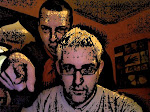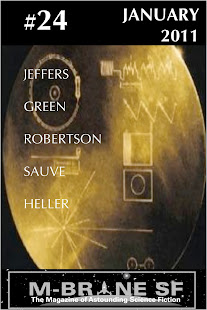

Reading
Paul of Dune reminded me once more of how often one runs into freakily intelligent and scarily capable young children in the sf genre. In
Dune, of course, one starts with Paul Atreides who cheated death repeatedly and overthrew a galactic empire while still in his teens. Then there is his sister Alia, an out-and-out freak, who becomes known by such scary monikers “the Abomination” and “St. Alia of the Knife.” Later there are Paul’s kids Leto and Ghanima—the “Children of Dune” themselves and fully as bizarre as Alia—with Leto becoming an even crazier, weirder galactic tyrant than his dad. The latest Anderson-Herbert installment in the series introduces a couple more terrifying kids, the Fenrings’ daughter Marie and the Tleilaxu creation Thallo (who is a
cutter…yeah, like a real-world teen cutter; he’s a morbid kid who cuts and burns himself on purpose and is engaged in a particularly extreme rebellion against his "parents").
Thinking of kids in sf then made me remember that there is an
Ender’s Game comic book now, based, of course, on Orson Scott Card’s famous novels. While I don’t read a lot of comics, I am interested in seeing this one if for no other reason than to see what someone’s idea of what that world looks like.
Ender’s Game, the novel, focuses on very young and very intelligent children with world-shaking capabilities--not super powers, or anything like that; they're just really damned smart. A live-action film is also rumored to be forthcoming, but I can’t imagine being able to do that in a watchable fashion with actors that would actually look as young as the novel’s lead characters are—cuz little kids generally suck in movies (see
Star Wars: The Phantom Menace in which that poor little fellow is made to say "Let's try spinning! That's a good trick!"). So I predict it would be re-imagined as a story about teenagers (who in turn would be played by actors nearly my age, shades of
Beverly Hill 90210 which Jeff now spends Saturday mornings indulging in reruns of on SoapNet). I should, before going on, mention that I’m
not a card-carrying “Enderverse” fanatic (despite the fact that I know the word "Enderverse") before a chorus of “gabba gabba,
we accept you,
we accept you,
ONE OF US!” starts up from that segment of the cybersphere...where there actually exists Ender slash fiction. I have read just four of the books (I think there’s probably like eight or ten of them now? See, I don’t even know and didn’t even bother looking it up when the internet is sitting right here in front of me...). The ones I have read are
Ender’s Game, Ender’s Shadow, Speaker for the Dead, and
Shadow of the Hegemon (that last one
listened to on a nicely done audio book introduced by Harlan Ellison). I loved, loved, loved
Ender’s Game and
Ender’s Shadow. Ender and Bean are characters that I will never forget and will always adore. Their parallel stories told in those two books is exciting, sweet, heroic, charming, harrowing and heartbreakingly, breathtakingly, achingly sad.
Ender’s Shadow even has a couple of chills-running-up-my-spine moments when key scenes from the first book happen again—such as Ender meeting Bean for the first time—except seen from Bean’s point-of-view. The other books did not move me as much though, and so I laid down that series. I’m not sure why they didn’t work for me. I think, however, that I might be failing to give more of Card’s books the attention they might deserve because I made the mistake of becoming too aware of the author’s politics. He posts political columns on his site. Though he’s not a raving, foaming-at-the-mouth ideologue, when I am looking at an sf writer’s web page or researching his books, I do not generally want any tendril of the right-wing blogosphere to encroach on that. I’m in fiction mode, not looking for real bullshit out of our stupid old effed-up real world. Oh, and a few years ago, he put out this embarrassing, god-awful wreck of a novel called
Empire, which was practically a political screed thinly disguised as fiction. Bill O’Reilly even appeared in it in a plot-important scene for ef’s sake! It was so bad that it caused me to actually blush at certain points during reading it. My ears got hot and my face flushed and I started glancing around surreptitiously, and that’s while I was sitting alone in a room reading something that was in no way my fault and which no one else even knew I had in my hands. [Dean Koontz does something similarly embarrassing in his otherwise charming
Brother Odd when he has some characters speculate that maybe their attackers are “Islamo-fascists” and then go on to quote some recent nonsense-of-the-day from the Iranian president]…Please, father of Ender! Never do anything like that again! You, too, father of Odd! I am considering coining a new item of writer lingo based on the
O’Reilly Factor scene in
Empire. The dictionary definition would be “the naked insertion of current events and political boiler-plate into a work of fiction in such a way that the author’s own views are loudly proclaimed and which has the effect of the author stepping into the story and kicking the reader out of it (and telling him or her to go watch more Fox News).” This term could simply be “pulling an oreilly” or maybe “dropping the o-bomb” or maybe “flippin’ an o”….I’ll give it some more thought. [The Card cover images with this post are from the Wikipedia entries on those novels.]











 are generally considered to be fantasy and that's not my genre of choice, even when the stories are supposedly
are generally considered to be fantasy and that's not my genre of choice, even when the stories are supposedly 













